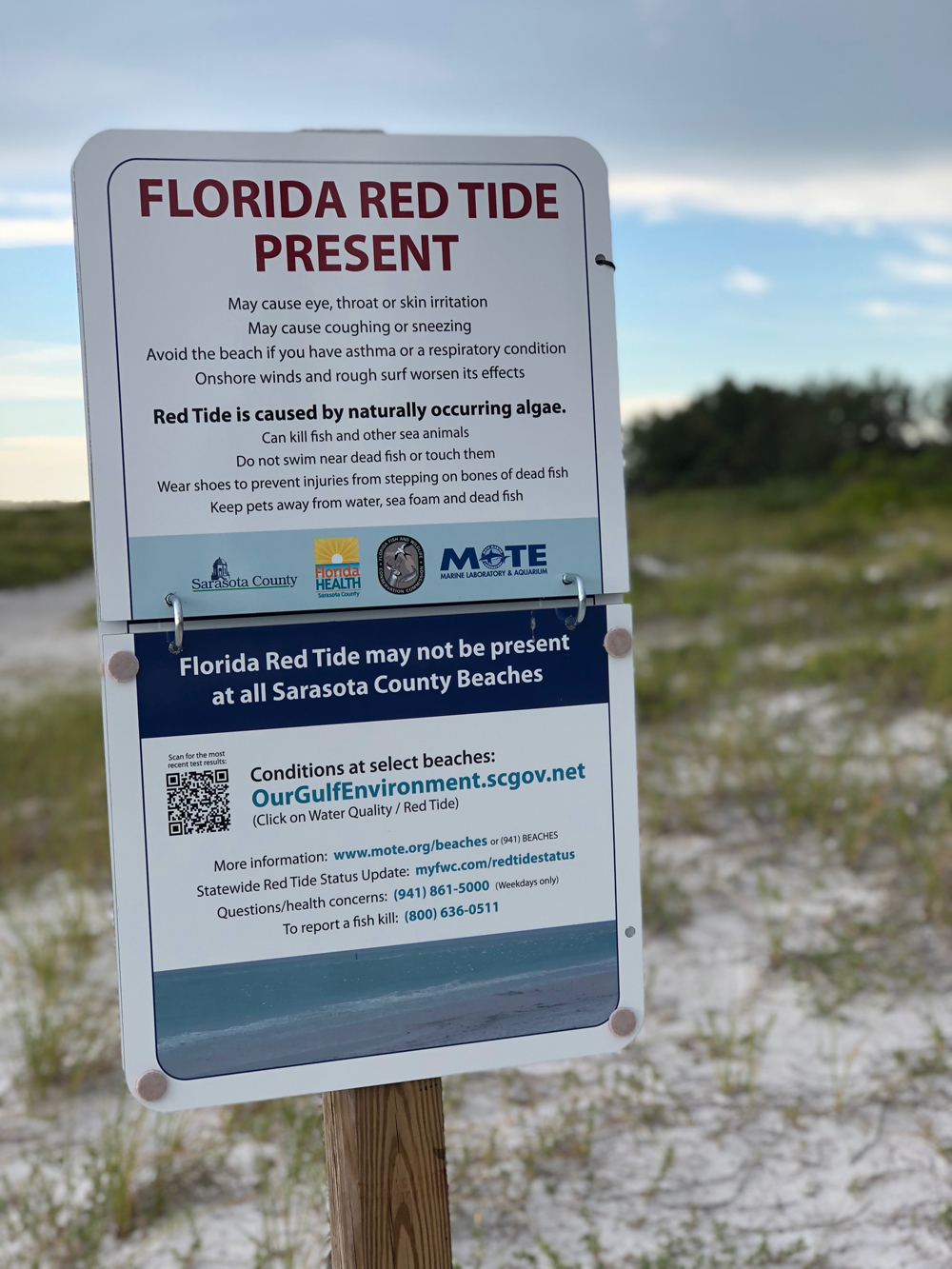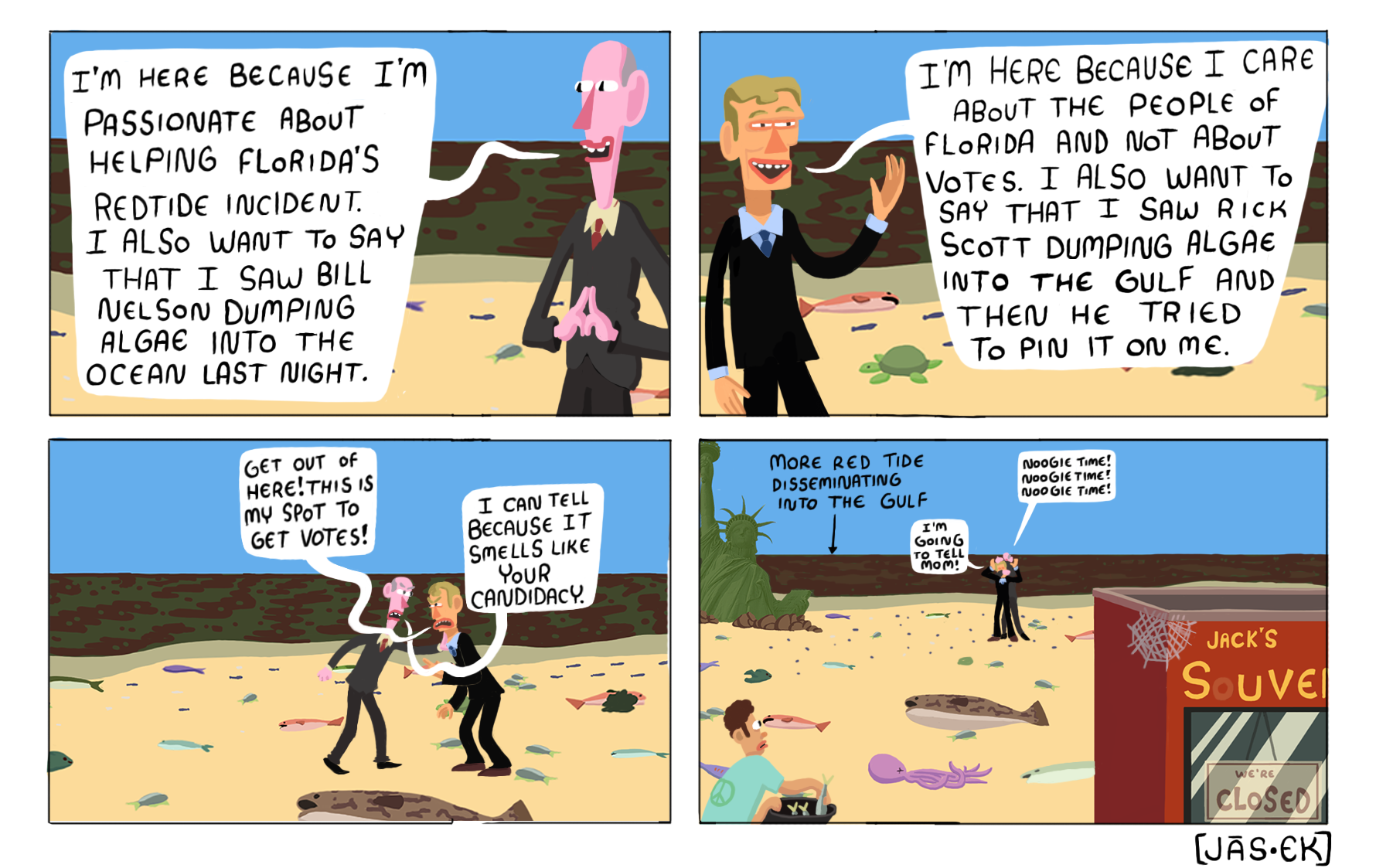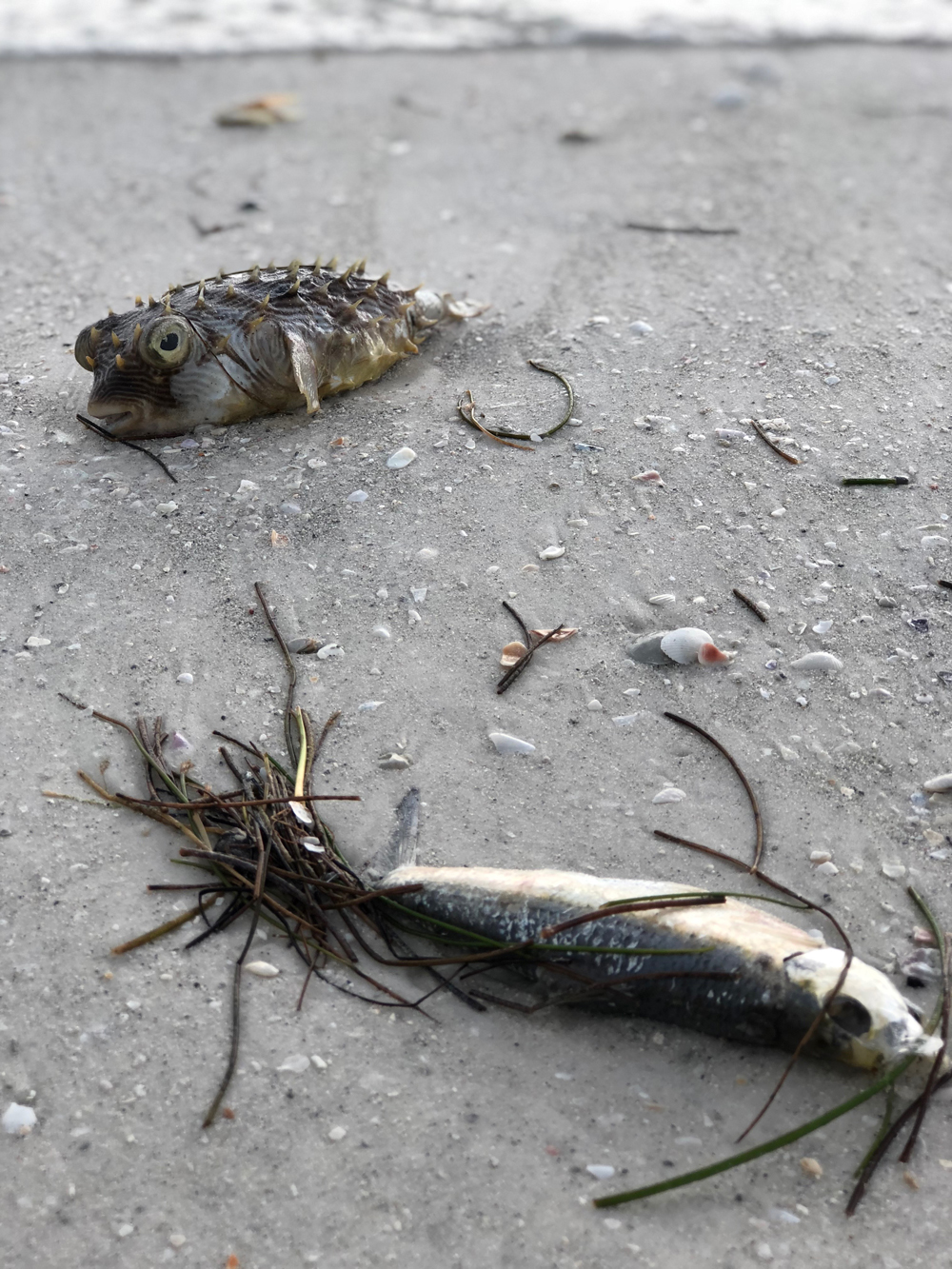This year’s algal bloom, seen as a red tide moving up the southwest coast of Florida, has been the most toxic in years, causing massive loss of sea life including thousands of fish, eels, turtles, dolphins and manatees. Human reactions range from eye and throat irritation to risk of death.Varying concentration levels of karenia brevis, the red tide organism that’s invading Florida, has been detected from Collier county up to Pinellas county since November 2017. According to the Environmental Protection Agency, direct exposure to toxic algae can cause respiratory and neurological issues, skin rashes and stomach or liver illnesses. During the first week of August alone, the Florida Fish and Wildlife Conservation Commission (FWC) has received reports of thousands of fish killed and over 50 reports of respiratory irritation.
Robert Weisberg, a physical oceanographer with the Ocean Circulation Group at the University of South Florida, predicts that the red tide will continue moving up the coast. “My guess is that it’s going to get worse before it gets better,” he said.
What are algae blooms?
Currently, Florida is experiencing two, large-scale algae outbreaks: blue-green algae and red tide. Blue-green algae is usually thick and mucky. It emits a foul smell and mainly grows in rivers and lakes. In contrast, red tide only grows in saltwater and is known for tinting coastal waters blood-red. Both types of blooms are natural annual occurrences. However, high concentrations of nutrient pollution (nitrogen and phosphorus) from agricultural fertilizer exacerbates and lengthens the duration of algal blooms when dumped into bodies of water.
Why is Florida experiencing this bloom?
Excess nutrient pollution discharged from Lake Okeechobee in particular, is responsible for Florida’s intensified red tide. Historically Lake Okeechobee’s precious freshwater drained south into the Everglades. The process helped the sophisticated subtropical wetlands, home to diverse and endangered wildlife, thrive. That is until two things happened in the 1960s: the Herbert Hoover Dike was built to protect against storm surges and floods and U.S. Sugar Corporation, the largest sugar company in the United States, turned hundreds of thousands of acres of the Everglades into land for sugarcane agriculture. Not only was Lake Okeechobee’s natural water flow reshaped but it was constantly polluted by high amounts of phosphorus from sugar farms’ fertilizer nutrients. As a result, an immense amount of pollution in the rising water of Lake Okeechobee is often discharged.
The U.S. Army Corps of Engineers is responsible for managing and releasing the toxic water into both the Gulf of Mexico and the Atlantic ocean through the St. Lucie and the Caloosahatchee rivers.

What is being done to combat it?
In 2000, a 35 year Comprehensive Everglades Restoration Plan (CERP) costing more than $10.5 billion— half paid by the state and half by the federal government— was signed into law . The CERP aims to “restore, preserve, and protect the south Florida ecosystem while providing for other water-related needs of the region, including water supply and flood protection.” The plan is comprised of 68 parts. If executed, the state will purchase 60,000 acres from the 500,000 acres of the Everglades Agricultural Area (EAA) in order to store and clean the water from Lake Okeechobee and restore the Everglades. Currently, the state has not purchased the land from US Sugar.
According to Everglades Trust, an organized group of people committed to protecting the Everglades and Florida’s coastal estuaries, “buying land for a reservoir that will clean water and send it south will stop damaging discharges to coastal estuaries, rehydrate the Everglades, and provide clean drinking water for more than 8 million Floridians.”
Although U.S. Sugar initially agreed to sell land from the Everglades Agricultural Area (EAA), they have also lobbied against CERP and donated generous contributions to Florida politicians over the years. The Orlando Sentinel reported that Florida Gov. Rick Scott “has taken more than than $600,000 from sugar interests through the years” and Republican Marco Rubio and Democrat Bill Nelson were also listed in the report as top beneficiaries of the sugar industry.
The Miami Herald and Tampa Bay Times Tallahassee bureau discovered, while conducting a review of state Division of Elections records, that “between 1994 and 2016, the sugar industry — led by United States Sugar and Florida Crystals — has steered a whopping $57.8 million in direct and in-kind contributions to state and local political campaigns. (The total does not include federal contributions).”
During Scott’s first gubernatorial term he cut funding, rolled back policies, and laid off 58 employees of the Florida Department of Environmental Protection (DEP). Meanwhile, numerous environmental conservation groups have implemented programs in an attempt to reduce pollution in Lake Okeechobee and restore the Everglades.
“Key storage solutions, such as the EAA reservoir and rehabilitation of the Herbert Hoover Dike are moving forward at an expedited pace at the state level, but additional action is still needed at the federal level,” Florida DEP spokeswoman Dee Ann Miller said.
During a press release on August 10, Gov. Scott said, “They [Washington] are currently short nearly a billion dollars in their fair share of contributions for Everglades restoration.” Congressional approval is still required to complete EAA reservoir.

Ways to make a change
Floridians vote at the general elections November 6. To help them make informed decisions at the polls, the Tampa Bay Times created a voter guide. Candidates running for governor, legislature, and county office in Hillsborough, Pinellas, Pasco and Hernando counties were surveyed on all types of issues including the environment.
Citizens can also voice their concerns over environmental issues by calling their state representatives and senators directly. To do so visit myfloridahouse.gov, click on representative and search by address.
Writing letters to local newspaper editors is also effective. Simply visit the website of your local newspaper which will provide easy instructions to submit a letter by email or an online form.
Want to take it a step further? These science-based environmental organizations are developing specific actions to curb the causes of toxic algal blooms in Florida: Water Keepers Alliance, Florida Water Environment Association, The Sierra Club and Environment Florida.



